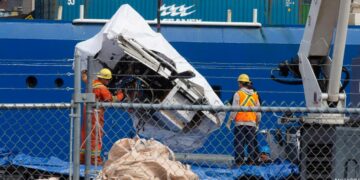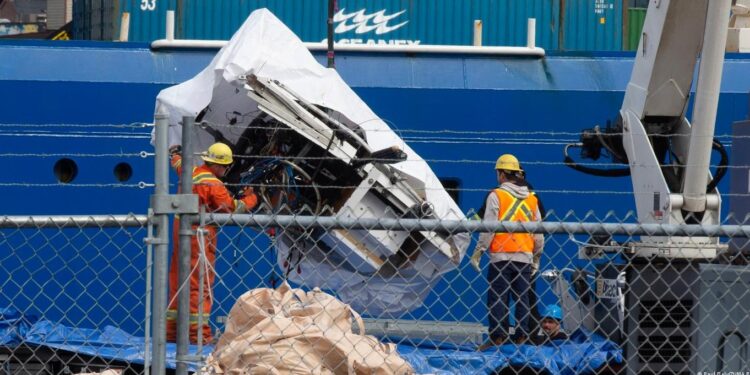By John Ikani
The US Coast Guard has announced the likely recovery of human remains from the wreckage of the ill-fated Titan submersible, which tragically imploded last week during its voyage to see the wreck of the Titanic, resulting in the loss of all five people on board.
As part of the investigation into the cause of the implosion, the debris retrieved from the Titan is being transported back to the United States.
The return of this crucial evidence to port in St. John’s, Newfoundland and Labrador on Wednesday marks a significant milestone in the ongoing inquiry.
The wreckage of the 22-foot submersible, twisted and broken, was unloaded at a Canadian Coast Guard pier.
The US Coast Guard reported late Wednesday that it had successfully retrieved debris and evidence from the sea floor, including presumed human remains.
Chief Capt. Jason Neubauer expressed his gratitude for the coordinated international and interagency support received in recovering and preserving this vital evidence, particularly given the extreme offshore distances and depths involved.
“This evidence will provide investigators from several international jurisdictions with critical insights into the cause of this tragedy,” stated Chief Capt. Neubauer.
He further emphasized that there is still substantial work to be done in understanding the factors that led to the catastrophic loss of the Titan and to prevent the recurrence of such a tragedy in the future.
The Canadian vessel Horizon Arctic played a pivotal role in the recovery operation, deploying a remotely operated vehicle (ROV) to search the ocean floor near the Titanic wreck for remnants of the submersible.
Pelagic Research Services, the company that owns the ROV, has completed its offshore operations but refrained from commenting on the ongoing Titan investigation due to the involvement of multiple government agencies in the United States and Canada.
Meanwhile, the Coast Guard’s investigation has entered a critical phase with the convening of a Marine Board of Investigation, the highest level of inquiry conducted by the Coast Guard.
Experts consulted during the search underscored the importance of analyzing the physical material of the retrieved debris, which could potentially yield crucial clues about the circumstances surrounding the Titan’s demise.
In addition, electronic data from the submersible’s instruments may provide valuable insights into the incident.
The tragic implosion claimed the lives of Ocean Gate CEO and pilot Stockton Rush, as well as Shahzada Dawood and his son Suleman Dawood, members of a prominent Pakistani family.
British adventurer Hamish Harding and Titanic expert Paul-Henri Nargeolet also perished in the accident. The National Transportation Safety Board and Transportation Safety Board of Canada, both involved in the investigation, declined to comment, emphasizing that the investigation is ongoing.
As the investigation progresses, the International Maritime Organization (IMO), the UN’s maritime agency, has confirmed that any investigative reports from the disaster will undergo review.
Member states of the IMO will have the opportunity to propose changes, including stricter regulations for submersibles, based on the findings.
Presently, the IMO has voluntary safety guidelines for tourist submersibles, encompassing inspections, emergency response plans, and the presence of certified pilots, among other requirements.
Proposed safety measures will likely be considered during the IMO’s upcoming Maritime Safety Committee session in May 2024.
OceanGate Expeditions, the US-based company that owned and operated the ill-fated Titan, had registered the submersible in the Bahamas.
Following the discovery of the Titan, the OceanGate company in Everett, Washington ceased operations. The Polar Prince, the Titan’s mother ship, hailed from Canada.
The implosion of the Titan has sparked concerns about the safety of private undersea exploration ventures, prompting the Coast Guard to prioritize enhancing submarine safety through the ongoing investigation.
As authorities continue their efforts to unravel the causes of this devastating incident, they hope to prevent similar tragedies in the future.




































